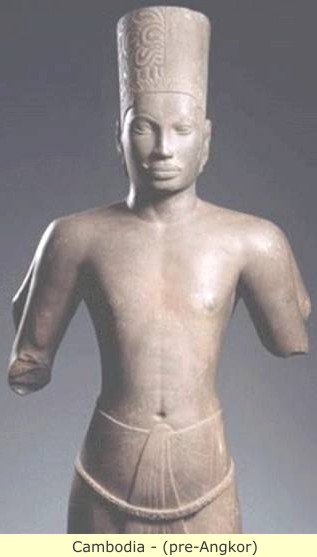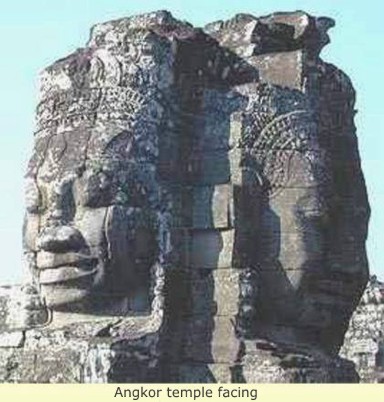Stopping the spread of communism was not the reason they sent so many troops......half a million at one point..............
It might have been the blacks who told the Chinese and Indians explorers.........that there was an enormous land mass on the other side of Africa............the Americas.........
\
 Angkor was not the only significant kingdom of its time in Southeast Asia. Another major Southeast Asian power and sometimes rival of Angkor was the kingdom of Champa. Champa was the great kingdom of the Blacks on the coast of Southeast Asia in central Vietnam. Indeed, the facial characteristics on the statues of the Cham are as Africoid as anywhere, including full lips and broad noses.
Angkor was not the only significant kingdom of its time in Southeast Asia. Another major Southeast Asian power and sometimes rival of Angkor was the kingdom of Champa. Champa was the great kingdom of the Blacks on the coast of Southeast Asia in central Vietnam. Indeed, the facial characteristics on the statues of the Cham are as Africoid as anywhere, including full lips and broad noses.
\
 Angkor was not the only significant kingdom of its time in Southeast Asia. Another major Southeast Asian power and sometimes rival of Angkor was the kingdom of Champa. Champa was the great kingdom of the Blacks on the coast of Southeast Asia in central Vietnam. Indeed, the facial characteristics on the statues of the Cham are as Africoid as anywhere, including full lips and broad noses.
Angkor was not the only significant kingdom of its time in Southeast Asia. Another major Southeast Asian power and sometimes rival of Angkor was the kingdom of Champa. Champa was the great kingdom of the Blacks on the coast of Southeast Asia in central Vietnam. Indeed, the facial characteristics on the statues of the Cham are as Africoid as anywhere, including full lips and broad noses.
The Cham are believed to have settled along the coastal plains of central Vietnam (Annam) more than two millennia ago. The economy of Champa was based on agriculture and maritime trade. They exported rice and forest products, including sandalwood, and essentially dominated the area from about the fourth century through the 13th century.
........
 Angkor was not the only significant kingdom of its time in Southeast Asia. Another major Southeast Asian power and sometimes rival of Angkor was the kingdom of Champa. Champa was the great kingdom of the Blacks on the coast of Southeast Asia in central Vietnam. Indeed, the facial characteristics on the statues of the Cham are as Africoid as anywhere, including full lips and broad noses.
Angkor was not the only significant kingdom of its time in Southeast Asia. Another major Southeast Asian power and sometimes rival of Angkor was the kingdom of Champa. Champa was the great kingdom of the Blacks on the coast of Southeast Asia in central Vietnam. Indeed, the facial characteristics on the statues of the Cham are as Africoid as anywhere, including full lips and broad noses.
THE KINGDOM OF CHAMPA
 Angkor was not the only significant kingdom of its time in Southeast Asia. Another major Southeast Asian power and sometimes rival of Angkor was the kingdom of Champa. Champa was the great kingdom of the Blacks on the coast of Southeast Asia in central Vietnam. Indeed, the facial characteristics on the statues of the Cham are as Africoid as anywhere, including full lips and broad noses.
Angkor was not the only significant kingdom of its time in Southeast Asia. Another major Southeast Asian power and sometimes rival of Angkor was the kingdom of Champa. Champa was the great kingdom of the Blacks on the coast of Southeast Asia in central Vietnam. Indeed, the facial characteristics on the statues of the Cham are as Africoid as anywhere, including full lips and broad noses.
The Cham are believed to have settled along the coastal plains of central Vietnam (Annam) more than two millennia ago. The economy of Champa was based on agriculture and maritime trade. They exported rice and forest products, including sandalwood, and essentially dominated the area from about the fourth century through the 13th century.
Chinese dynastic records from as early as 192 C.E. reference a kingdom of Lin-yi, which meant the “land of Black men.” The kingdom of Lin-yi was known as Champa in Sanskrit documents. They stated the inhabitants possessed “‘black skin, eyes deep in the orbit, nose turned up, hair frizzy” at a period when they were not yet subject to foreign domination and preserved the purity of this type. These records expressly state that: “For the complexion of men, they consider Black the most beautiful. In all the kingdoms of the southern region, it is the same.”
During this same period Cham ships, known to the Chinese by the appellation kun-lun bo (the “vessels of Black men”), were navigating the currents of the Indian Ocean from Southeast Asia to Madagascar.
Among the major centers of Champa were those based near Dong Duong, Tra Kieu and Pandulanga (Phan-Rang). The great southem capital was Vijaya (Binh Dinh), and the early northern capital and religious center was Mi Son.
More than 70 temples were constructed at Mi Son from the seventh century through the 12th centuries. The masterpiece of Cham architecture at Mi Son was an enormous, 70-foot-high stone tower that was destroyed by United States Army commandos in August 1969.
Thursday, September 3, 2015
.........................
 From the 9th to the 15th centuries, the Khmer kingdom at Angkor was the most powerful and architecturally prodigious culture in Southeast Asia. The Khmers had lived for millennia in this region, and had earlier kingdoms known as Funan and Chenla. These kingdoms were the superpowers of the region in ancient times, but as of late, had been dominated by the new regional superpowers of the time, namely China to the north and Java to the south.
From the 9th to the 15th centuries, the Khmer kingdom at Angkor was the most powerful and architecturally prodigious culture in Southeast Asia. The Khmers had lived for millennia in this region, and had earlier kingdoms known as Funan and Chenla. These kingdoms were the superpowers of the region in ancient times, but as of late, had been dominated by the new regional superpowers of the time, namely China to the north and Java to the south.
 But the Khmer were not done, they immediately regrouped for an attempt to take back Angkor. A cousin of the executed king led the charge, and Angkor was retaken around 1180 A.D. This victorious Prince, was crowned as king Jayavarman VII. For the next four decades, Jayavarman VII would reign over Angkor's greatest period.
But the Khmer were not done, they immediately regrouped for an attempt to take back Angkor. A cousin of the executed king led the charge, and Angkor was retaken around 1180 A.D. This victorious Prince, was crowned as king Jayavarman VII. For the next four decades, Jayavarman VII would reign over Angkor's greatest period.




Ancient Man and His First Civilizations
The Khmer of Cambodia
In Cambodia, the second great Khmer Empire to arise, after the fall of Funan, was that of Angkor: This ancient Cambodian empire held power from the 9th to the 15th centuries. The city of Angkor was located in the modern Cambodian province of Siem Reap, which is in the northwest of the country. "Angkor" itself is a Cambodianized interpretation of the Sanskrit word nagara, which means "city."
 |
 From the 9th to the 15th centuries, the Khmer kingdom at Angkor was the most powerful and architecturally prodigious culture in Southeast Asia. The Khmers had lived for millennia in this region, and had earlier kingdoms known as Funan and Chenla. These kingdoms were the superpowers of the region in ancient times, but as of late, had been dominated by the new regional superpowers of the time, namely China to the north and Java to the south.
From the 9th to the 15th centuries, the Khmer kingdom at Angkor was the most powerful and architecturally prodigious culture in Southeast Asia. The Khmers had lived for millennia in this region, and had earlier kingdoms known as Funan and Chenla. These kingdoms were the superpowers of the region in ancient times, but as of late, had been dominated by the new regional superpowers of the time, namely China to the north and Java to the south.
In 802 A.D, a Khmer official in the Javanese court, returned to his homeland, declared himself the new god-king, and took the name Jayavarman II. He then declared full independence from Java. Jayavarman II, thus became the first of many deified kings of Angkor.
Angkor reached its "first" peak with the ascension of Suryavarman II in 1112 A.D. Suryavarman II expanded the kingdom into Vietnam and Thailand, and built the famed Shiva temple of Angkor Wat. But the southern Vietnamese state of Champa would not be subjugated.
In 1177 A.D, the Chams of Vietnam regrouped, and launched a covert counterattack. They quietly sailed up the great lake of central Cambodia - the Tonle Sap and attacked Angkor. With this attack, the Cham began to take the offensive, and within a few years, the Chams had sacked Angkor and executed its king.
 But the Khmer were not done, they immediately regrouped for an attempt to take back Angkor. A cousin of the executed king led the charge, and Angkor was retaken around 1180 A.D. This victorious Prince, was crowned as king Jayavarman VII. For the next four decades, Jayavarman VII would reign over Angkor's greatest period.
But the Khmer were not done, they immediately regrouped for an attempt to take back Angkor. A cousin of the executed king led the charge, and Angkor was retaken around 1180 A.D. This victorious Prince, was crowned as king Jayavarman VII. For the next four decades, Jayavarman VII would reign over Angkor's greatest period.
Jayavarman VII's reign was the pinnacle of Khmer culture, but after his death, things began to slip away. By the 15th and 16th centuries, the Thai kingdom of Ayutthaya was in ascendance, and after several unsuccessful attempts at destroying the Khmers, they finally sacked Angkor in 1431 A.D. and then again in 1594 A.D. The last sacking forced the Khmer to abandon their capital at Angkor. The Khmer eventually regrouped in a new capital at Phnom Penh, many miles to the south, but the glory period of Khmer history was over.


Over time Cambodia was continually subjugated by its now, more powerful Mongol neighbors. As each of them in their turn, gained control of Cambodia, that precipitated the movement of Mongol people into Cambodia. Finally in 1863 A.D, Cambodia became a French territory, by then all had been lost, and the Khmer had been absorbed, producing the current inhabitants.


And i know Angor Wat is in Cambodia............wars tend to spill over........from one country to its neighbors.............and if there was stuff in Cambodia........chances are there might be in Vietnam......
Angkor - UNESCO World Heritage Centre
whc.unesco.org › ... › The List
They include the famous Temple of Angkor Wat and, at Angkor Thom, the Bayon Temple with its countless sculptural decorations. UNESCO has set up a ...
UNESCO World Heritage Site

No comments:
Post a Comment